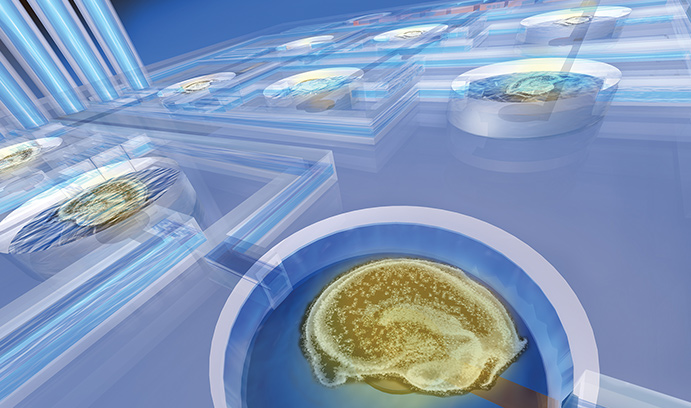Seeking Speedier Drug Delivery

Multiple microwells on Berdichevsky's assay chips make it possible to test up to 18 drug candidates at a time. (Illustration by Linda Nye)
About 125,000 Americans each year develop epilepsy, a brain disease marked by recurring seizures that are sudden and unpredictable and can have dangerous and even fatal consequences. There is no known cure, but medications can control seizures.
Some 30 percent of epilepsy patients, however, suffer seizures that do not respond to existing medications, says Yevgeny Berdichevsky. And the gradual onset and slow progression of the disease complicate efforts by researchers to identify and test new anticonvulsant drugs quickly.
Berdichevsky, an assistant professor of electrical and computer engineering, recently received a grant from the National Institutes of Health to help speed the process of drug discovery by testing multiple potential epilepsy medications simultaneously. By performing drug assays on 1-inch-square chips imprinted with microwells, he reduces the area required to grow individual epilepsy cultures, or tissue samples, and makes it possible to test as many as 18 drug candidates at one time.
A network of microfluidic channels divides the samples into experimental groups while enabling the “feeding” of the samples, which require large amounts of glucose and amino acids. The channels, which Berdichevsky is developing with help from Jing Liu, a Ph.D. candidate in electrical engineering, also facilitate the application of drugs, inhibitors and other molecules.
The individual research techniques that Berdichevsky employs—imprinting electrodes on a chip and patterning the chip surface with microfluidics—are well-established. What makes his approach novel, he says, is combining the two techniques to perform experimental tests on 3D tissue samples.
“Our goal is to increase the rate of drug development by significantly improving the scalability of long-term electrical monitoring of epileptic activity in vitro,” he says. “In the end, the testing of multiple drugs at a time is an engineering problem.”
Berdichevsky hopes to scale up his testing platform so that it can screen small-molecule inhibitor candidates in drug libraries. “What we’re doing is early-stage drug target discovery. If we find that a molecule inhibits epileptic activity, that tells us what protein is causing epileptic activity and would be a good target for a drug.”
Berdichevsky, a faculty member in Lehigh's bioengineering program, began studying epilepsy five years ago at Massachusetts General Hospital. He and his collaborators, including graduate and undergraduate students, have published articles in The Journal of Neuroscience, Lab on a Chip, the Journal of Neuroscience Methods and the Neurobiology of Disease.
Posted on:


